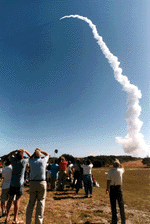![]()
![]()
 |
For the first two minutes of flight, a set of nine smaller rockets attached in a ring formation around the outside of stage one helped it accelerate. McDonnell Douglas refers to these nine "helper" rockets as solid-rocket motors because they burn a solid putty-like material instead of liquid propellant.
Six of the nine solids ignited along with stage one at the time of lift-off. Approximately 60 seconds into the flight, those six burned out and were jettisoned. Then, the remaining three solids ignited and burned for the next 60 seconds before falling away. After the last of the solid rockets dropped away, stage one continued to thrust until its propellant ran out. At the time of stage one jettison, four minutes and 20 seconds after lift-off, the Delta had reached a velocity of 6,200 meters per second (13,870 miles per hour) and climbed to an altitude of 115 kilometers (71 miles).
Stage two ignited several seconds after jettison of the first stage. Nine minutes and 37 seconds after lift-off, its engine shut down to place the Delta into a circular orbit around the Earth at an altitude of 185 kilometers (115 miles). Orbit insertion occurred 2,524 kilometers (1,568 miles) southeast of Cape Canaveral with the rocket traveling at 7,793 meters per second (17,432 miles per hour).
For the next half hour, the Delta coasted around the Earth until it reached a position over the mid-Indian Ocean. Then, the second stage engine restarted and performed a two-minute burn to boost the Delta's velocity to 8,766 meter per second (19,608 miles per hour). Jettison of stage two followed moments after the completion of the two-minute engine firing.
The third stage engine ignited roughly half a minute after the second stage fell away. This stage thrusted for 87 seconds to perform what the flight team called the TMI or "trans-Mars injection" burn. After the completion of TMI, Surveyor was moving at 11,449 meters per second (25,611 miles per hour), a speed equivalent to 34 times faster than a speeding bullet.
The enormous velocity provided by the Delta's three stages allowed the spacecraft to escape the pull of the Earth's gravity and never return. Shortly after TMI, stage three separated itself from Surveyor to allow the spacecraft to begin its long journey toward Mars.